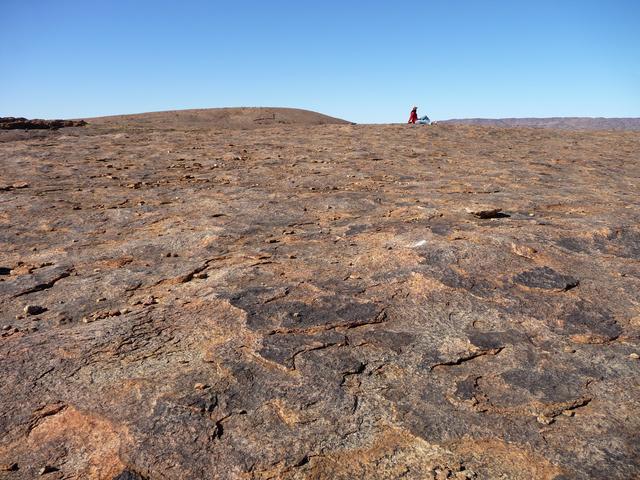 Augrabies Falls National Park is in the Northern Cape province of South Africa.
Augrabies Falls National Park is in the Northern Cape province of South Africa.
Augrabies Falls National Park is a national park located around its main attraction, the Augrabies Falls, about 120 km west of Upington. The park covers an area of 820 km² and stretches along the Orange River. The area is very arid. The waterfall is about 60 m high and is awe-inspiring when the river is in flood. The gorge below the falls averages about 240 m deep and runs for 18 km. The gorge provides an impressive example of erosion into a granitic basement.
Established in 1966, the original Khoikhoi people named the waterfall Ankoerebis, meaning the "place of big noises". The Trekboers who later settled in the area derived the name Augrabies. The name is sometimes spelt Aughrabies.
 A prominent landmark in the park is Moon Rock, a large exfoliation dome measuring around 700 m (2,300 ft) by 100 m (330 ft) and 30 m (98 ft) high.
A prominent landmark in the park is Moon Rock, a large exfoliation dome measuring around 700 m (2,300 ft) by 100 m (330 ft) and 30 m (98 ft) high.
 The most characteristic plant in the park is the giant aloe (Aloe dichotoma) known locally as the quiver tree or kokerboom. It is perfectly adapted to the dry semi-desert rocky areas found in the Nama-Karoo, able to withstand the extreme temperatures and the infertile soil. This tree, which grows up to five metres high, gets its name from the fact that the Bushmen (San) used the soft branches to make quivers for their arrows. The eye-catching silhouette of the quiver tree is typical of this part of Northern Cape landscape. When the tree flowers in the winter flocks of birds are attracted to their copious nectar, and baboons can be seen tearing the flowers apart to get the sweet liquor.
The most characteristic plant in the park is the giant aloe (Aloe dichotoma) known locally as the quiver tree or kokerboom. It is perfectly adapted to the dry semi-desert rocky areas found in the Nama-Karoo, able to withstand the extreme temperatures and the infertile soil. This tree, which grows up to five metres high, gets its name from the fact that the Bushmen (San) used the soft branches to make quivers for their arrows. The eye-catching silhouette of the quiver tree is typical of this part of Northern Cape landscape. When the tree flowers in the winter flocks of birds are attracted to their copious nectar, and baboons can be seen tearing the flowers apart to get the sweet liquor.
Fauna include giraffe, leopard, kudo, eland, steenbok, dassie, and an exceptionally high concentration of lizards. Vervet monkeys and baboons have become habituated to humans and will take any unattended food.
Extremely hot in summer, with the December maximum averaging 36°C. Rooms are air-conditioned, but camping can be unpleasant, and many of the walks are not advisable in the heat.

Vaild to 31 October 2017:
- South African citizens and residents (with ID): R44 per adult, R22 per child, per day
- SADC nationals (with passport): R88 per adult, R44 per child, per day
- Foreign visitors: R176 per adult, R88 per child, per day
- Children under 2 have free entry.
Take an easy walk to the waterfalls from the park reception area. There are a number of lookout points. The falls are also lit up until 10pm for a spectacular (and much cooler) night view.
Hot-air ballooning (in the cooler months only) and white-water rafting are available outside of the park.
There are also short hikes, and the 3-day Klipspringer hike (closed in summer) available.
An ATM and petrol station is available at the main camp. The small shop next to the reception sells curios and some food supplies.
There is a restaurant in the park serving mostly meat dishes, with limited vegetarian fare. The small shop also sells some food items.
Visiting in the summer, you will need to drink a lot! The restaurant has a bar area, and the shop also sells alcohol Monday to Saturday.
Most of the risks are of the wild variety, with baboons and vervet monkeys likely to steal unattended food (or raid a cottage left with its windows open). Care also needs to be taken to avoid scorpion stings and snakebites when walking in the park.
The park also falls into a marginal malaria area, but the risk is low and most visitors don't bother with prophylactics.
